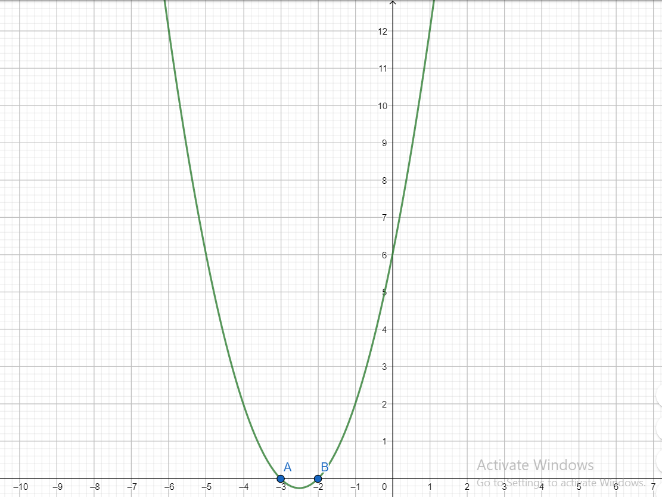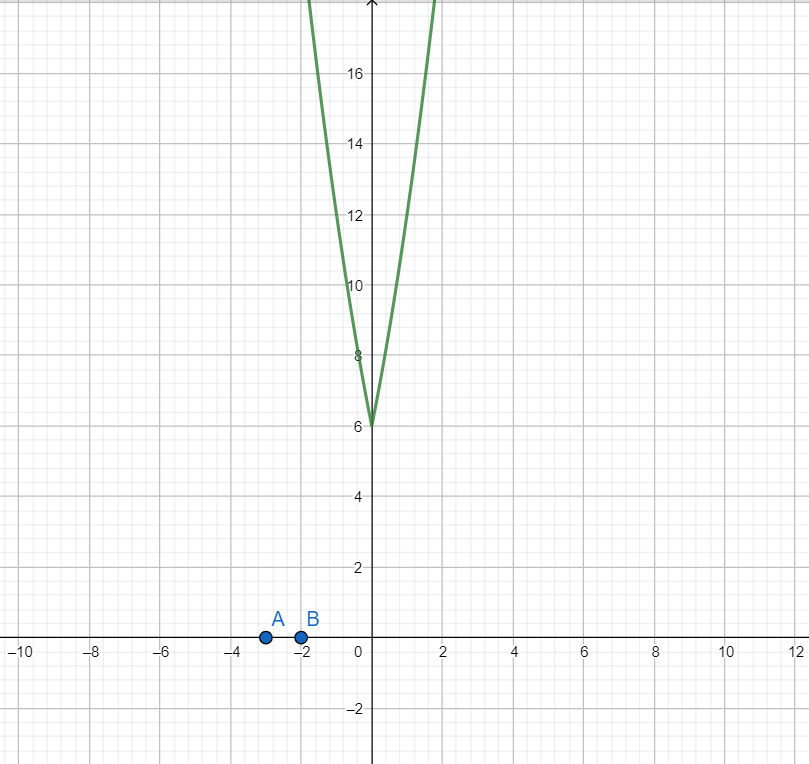
The sum of real roots of the equation ${{x}^{2}}+5\left| x \right|+6=0$ is
A. 5
B. 10
C. -5
D. None of these.
Answer
603.9k+ views
Hint: Solve for cases when x>0 and $x\le 0$ individually and remove extraneous roots(means which does not satisfy two cases). Use property that |x| = x when x>0 and |x| = -x when $x\le 0$. Find the sum of all the real roots found. Alternatively, you can plot the given function and find the points at which the graph of the given function intersects the x-axis.
“Complete step-by-step answer:”
We will solve the above question for two cases.
Case I: x>0
We have |x| = x
$\Rightarrow {{x}^{2}}+5x+6=0$
Using the quadratic formula which states that for quadratic equation $a{{x}^{2}}+bx+c=0$ the roots are $x=\dfrac{-b\pm \sqrt{{{b}^{2}}-4ac}}{2a}$
Here a = 1, b = 5 and c = 6
Using the quadratic formula, we get
$\begin{align}
& x=\dfrac{-5\pm \sqrt{{{5}^{2}}-4\left( 1 \right)\left( 6 \right)}}{2\left( 1 \right)} \\
& \Rightarrow x=\dfrac{-5\pm \sqrt{25-24}}{2} \\
& \Rightarrow x=\dfrac{-5\pm \sqrt{1}}{2}=\dfrac{-5\pm 1}{2} \\
& \Rightarrow x=\dfrac{-5+1}{2}\text{ or }x=\dfrac{-5-1}{2} \\
& \Rightarrow x=-2\text{ or }x=-3 \\
\end{align}$
Since x>0 both x = -2 and x = -3 are extraneous roots.
Case II: $x\le 0$
We have |x| = -x
$\Rightarrow {{x}^{2}}-5x+6=0$
Here a = 1, b = -5 and c = 6
Using the quadratic formula, we get
$\begin{align}
& x=\dfrac{-\left( -5 \right)\pm \sqrt{{{\left( -5 \right)}^{2}}-4\left( 1 \right)\left( 6 \right)}}{2\left( 1 \right)} \\
& \Rightarrow x=\dfrac{5\pm \sqrt{25-24}}{2} \\
& \Rightarrow x=\dfrac{5\pm \sqrt{1}}{2}=\dfrac{5\pm 1}{2} \\
& \Rightarrow x=\dfrac{5+1}{2}\text{ or }x=\dfrac{5-1}{2} \\
& \Rightarrow x=3\text{ or }x=2 \\
\end{align}$
Since $x\le 0$, both x = 3 and x =2 are extraneous roots.
Hence the given equation has no real roots
Hence option D is correct.
Note: Alternative solution:
If we know the graph of f(x) then the graph of f(|x|) is the same as the graph f(x) for x>0 and for $x\le 0$ the graph is the mirror image taken in the y-axis.
Let $f(x)={{x}^{2}}+5x+6$
Then $f\left( \left| x \right| \right)={{x}^{2}}+5\left| x \right|+6$
First, we draw the graph of f(x)

Then using the above-mentioned fact, we draw the graph of f(|x|)

As is evident from the graph, the function f(|x|) does not have any root because it does not intersect the x-axis.
Hence the given equation ${{x}^{2}}+5\left| x \right|+6=0$ has no real roots.
“Complete step-by-step answer:”
We will solve the above question for two cases.
Case I: x>0
We have |x| = x
$\Rightarrow {{x}^{2}}+5x+6=0$
Using the quadratic formula which states that for quadratic equation $a{{x}^{2}}+bx+c=0$ the roots are $x=\dfrac{-b\pm \sqrt{{{b}^{2}}-4ac}}{2a}$
Here a = 1, b = 5 and c = 6
Using the quadratic formula, we get
$\begin{align}
& x=\dfrac{-5\pm \sqrt{{{5}^{2}}-4\left( 1 \right)\left( 6 \right)}}{2\left( 1 \right)} \\
& \Rightarrow x=\dfrac{-5\pm \sqrt{25-24}}{2} \\
& \Rightarrow x=\dfrac{-5\pm \sqrt{1}}{2}=\dfrac{-5\pm 1}{2} \\
& \Rightarrow x=\dfrac{-5+1}{2}\text{ or }x=\dfrac{-5-1}{2} \\
& \Rightarrow x=-2\text{ or }x=-3 \\
\end{align}$
Since x>0 both x = -2 and x = -3 are extraneous roots.
Case II: $x\le 0$
We have |x| = -x
$\Rightarrow {{x}^{2}}-5x+6=0$
Here a = 1, b = -5 and c = 6
Using the quadratic formula, we get
$\begin{align}
& x=\dfrac{-\left( -5 \right)\pm \sqrt{{{\left( -5 \right)}^{2}}-4\left( 1 \right)\left( 6 \right)}}{2\left( 1 \right)} \\
& \Rightarrow x=\dfrac{5\pm \sqrt{25-24}}{2} \\
& \Rightarrow x=\dfrac{5\pm \sqrt{1}}{2}=\dfrac{5\pm 1}{2} \\
& \Rightarrow x=\dfrac{5+1}{2}\text{ or }x=\dfrac{5-1}{2} \\
& \Rightarrow x=3\text{ or }x=2 \\
\end{align}$
Since $x\le 0$, both x = 3 and x =2 are extraneous roots.
Hence the given equation has no real roots
Hence option D is correct.
Note: Alternative solution:
If we know the graph of f(x) then the graph of f(|x|) is the same as the graph f(x) for x>0 and for $x\le 0$ the graph is the mirror image taken in the y-axis.
Let $f(x)={{x}^{2}}+5x+6$
Then $f\left( \left| x \right| \right)={{x}^{2}}+5\left| x \right|+6$
First, we draw the graph of f(x)

Then using the above-mentioned fact, we draw the graph of f(|x|)

As is evident from the graph, the function f(|x|) does not have any root because it does not intersect the x-axis.
Hence the given equation ${{x}^{2}}+5\left| x \right|+6=0$ has no real roots.
Recently Updated Pages
Master Class 12 Economics: Engaging Questions & Answers for Success

Master Class 12 Maths: Engaging Questions & Answers for Success

Master Class 12 Biology: Engaging Questions & Answers for Success

Master Class 12 Physics: Engaging Questions & Answers for Success

Master Class 8 Maths: Engaging Questions & Answers for Success

Class 8 Question and Answer - Your Ultimate Solutions Guide

Trending doubts
What is meant by exothermic and endothermic reactions class 11 chemistry CBSE

10 examples of friction in our daily life

One Metric ton is equal to kg A 10000 B 1000 C 100 class 11 physics CBSE

1 Quintal is equal to a 110 kg b 10 kg c 100kg d 1000 class 11 physics CBSE

Difference Between Prokaryotic Cells and Eukaryotic Cells

What are Quantum numbers Explain the quantum number class 11 chemistry CBSE




